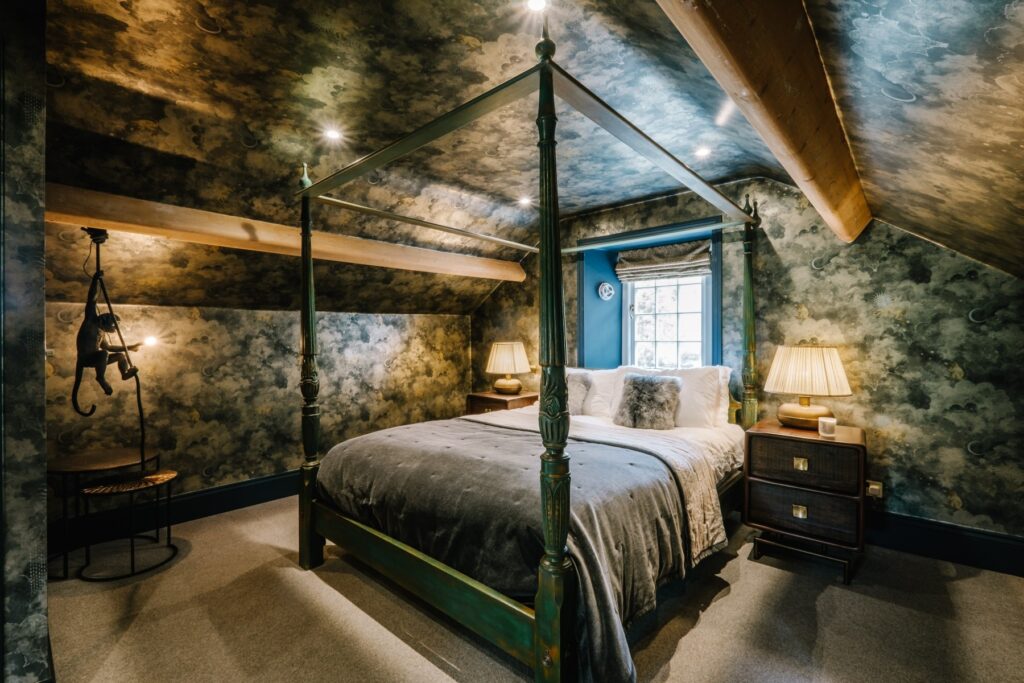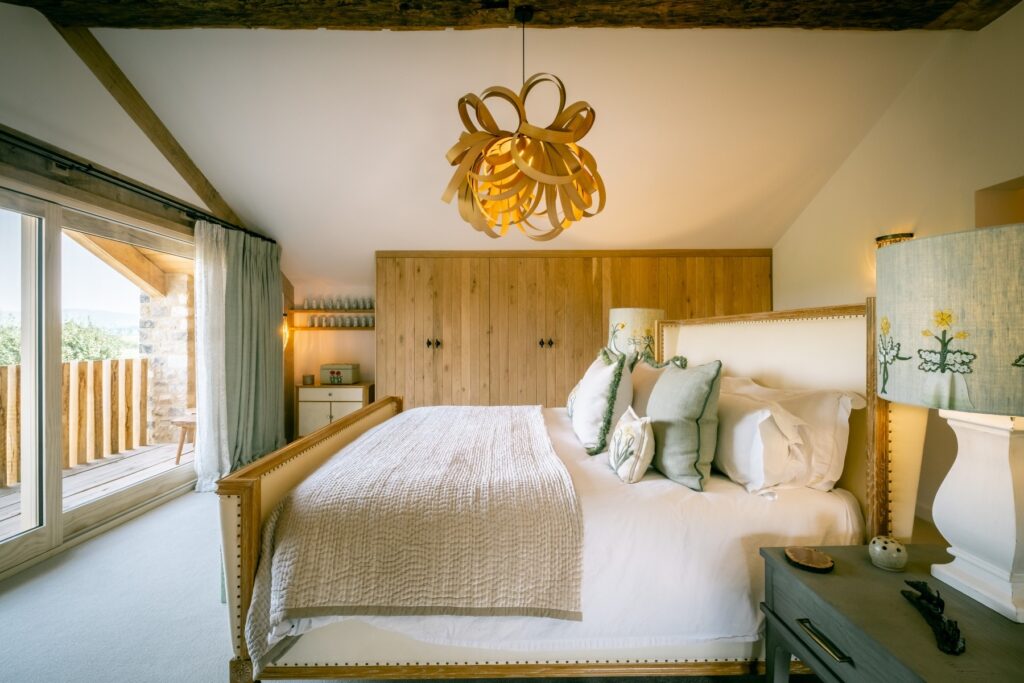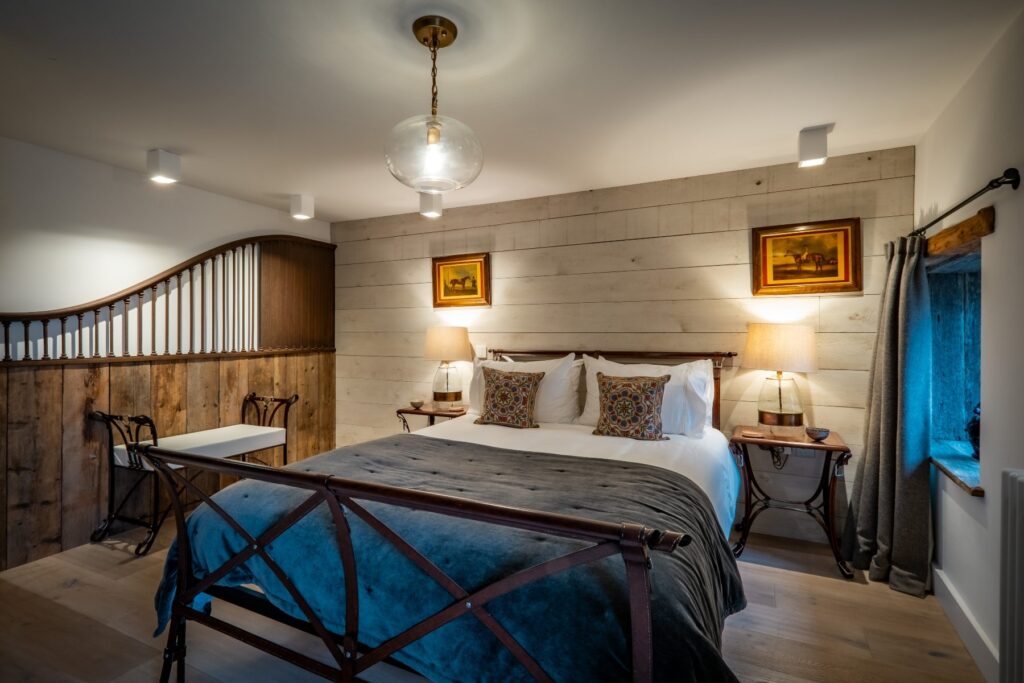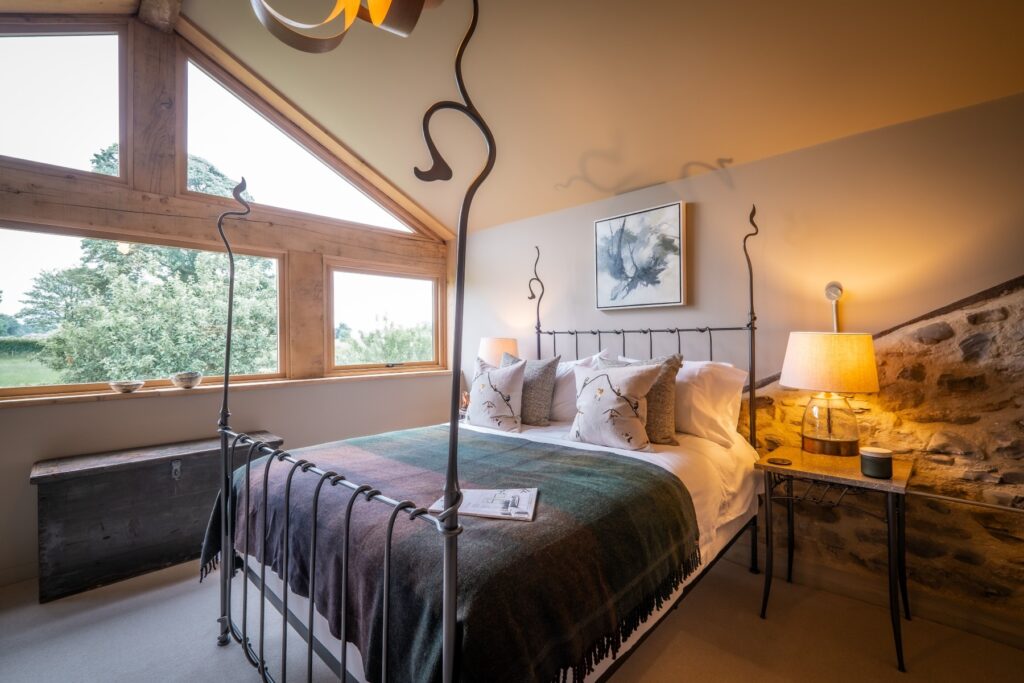Did you know that sleep fills a third of our lives? And that studies have shown around a third of us to be sleep deprived? Those two facts caught my attention and focused it on optimal bedroom designs that can aid our sleep. Interior design can have such an impact on sleep hygiene and I think we biophilic designers in particular should aim to help our clients sleep their way to wellness.
Biophilic Design Helps Sleep
The world sleep epidemic is becoming a major health challenge. Scientists are now convinced that our bodies require sleep in the same way that they require oxygen and water.
“Sleep is not an optional lifestyle luxury but a non-negotiable biological necessity. No one would look at an infant baby asleep, and say, ‘What a lazy baby!’ We know sleeping is non-negotiable for a baby. But that notion is quickly abandoned as we grow up. Humans are the only species that deliberately deprive themselves of sleep for no apparent reason.”
Matthew Walker, author of Why we Sleep.
So, what can we do to ensure we get the sleep we need? I firmly believe that biophilic design has the answers. Introducing human-centred, nature-focused design elements into your bedroom will go a long way to helping you achieve a better night’s sleep.
A bedroom should engage all the senses from the moment you enter it. We know that being surrounded by nature has a calming effect, so I seek to create tranquil and peaceful bedrooms that ultimately promote wellness. I always use natural materials to achieve exactly this.

Through the incorporation of nature-inspired accessories, natural materials and earthy tones, my biophilic designs infuse spaces with the natural raw beauty of the outdoors. Aesthetics really do play a vital role in the creation of a calming space, one that allows us to recharge and promotes wellbeing. I seek to balance elements and create safe, beautiful, naturally-sustainable, fabulous spaces that promote both mental and physical wellbeing.
Our homes are our sanctuaries, they provide refuge from our increasingly busy lives. They’re a place to escape our hectic world, allowing us to switch off, relax and replenish our energy. Designing for self-care and wellness really should be the number one priority in our homes – creating a bedroom environment that minimises sleep disruption and promotes restful sleep is simply vital.
Sleep is the foundation of wellness
When you sleep well, you think well, feel well and even eat well. If we consistently sleep well, we have more energy in going about our daily tasks, enjoy the people around us more, and have a greater appreciation for our environment. Good sleep is also vital for our creativity and productivity.
We are a diurnal species, naturally active in the day, and when dark descends it is time to sleep.
“Sleep is the single most effective thing we can do to reset our brain and body health each day – Mother Nature’s best effort yet at contra-death. Unfortunately, the real evidence that makes clear all of the dangers that befall individuals and societies when sleep becomes short have not been clearly telegraphed to the public. It is the most glaring omission in the contemporary health conversation”.
Matthew Walker, Professor of Neuroscience and Psychology, University of California, Berkeley
Actionable design tips
Bedtime should be a sacred time, a time when we nourish ourselves. Our bedrooms are our sanctuaries, a space in which to relax and recharge. They should be intimate, luxurious and personal. Our bedrooms should promote comfort, intimacy, familiarity and well-being. From a design perspective, there are many things we can do to make our bedrooms more conducive to sleep.
So, I’m sharing some actionable tips for rest, relaxation and regeneration. Our surroundings affect us in powerful ways, applying these tips to your bedroom will aid your sleep quality:
Colour
- Colour plays a significant role in whether a bedroom feels relaxing. Colour impacts on both our emotional and physical wellbeing.
- Take cues from nature’s colour palette and opt for soft neutral shades. This aids your sleep patterns and your body’s natural circadian rhythms.
- Blues, greens and greys reduce your heart rate, lower blood pressure and slow down your rate of breathing. All good conditions in which to begin your night of great sleep!
- Green is a good colour option, and is considered stress relieving. Soft pastel shades work best and create a connection to nature that’s healing and rejuvenating.
- For a minimalistic look, you could paint the walls white and use green as an accent colour.
- Choose paints that are free from toxic VOC’s (volatile organic compounds).

Plants
- Biophilic interior design has shown the wide range of health benefits that house plants bring to a space. These include purer air, improved mood and increased productivity.
- Incorporating air filtering plants will aid sleep and improve the aesthetic of the room.
- Greenery/plants can reduce physiological and psychological stress. By incorporating plants into our bedrooms, we can create a happier and healthier environment.
- Plants are our oldest and most human-friendly air filters. Spider plants, snake plants and Boston ferns are all easy to maintain and have toxin-filtering properties.
Art
Adding art into your bedroom that depicts nature is a further way of harnessing the power of the natural world, allowing you subliminal access to its restorative powers.
- You can choose photos, paintings, drawings and even wallpaper that depicts scenes of nature. Read my Biophilic Art Project.
- Research has found that just looking at pictures of nature can help reduce stress.
- Abstract natural art also provides a connection to nature. Artist, Joanna Farrow uses nature to create her gorgeous pieces of art. Not only do her drawings/paintings bring nature into your room but the colours she uses also create calm. Joanna Farrow art.
Natural objects & finishes
- Consider placing a curated selection of non-living natural elements such as shells, drift wood or stones on a surface.
- Incorporate natural finishes and furnishings into a bedroom – elements such as wood flooring, wood cladding.
- Wood also absorbs sound, it insulates, does not transmit static and is naturally beautiful.

Clutter
- Reducing the clutter in your bedroom is key. When designing a bedroom, I consider how the space will be used and create clutter-free environments by designing effective storage solutions.
- Seek to maximise comfort and allow free space for movement. Clutter has been shown to be stress inducing – you simply cannot relax if your surfaces are full of stuff.
- Consider your bedroom as a sleep sanctuary, one that is beautifully clean and fresh. Clutter adds to fatigue, anxiety, and unrest, which leads to an increase in the stress hormone cortisol.
- Bombarding our minds with excessive stimuli is the last thing we want in our bedrooms. Pack away the clutter and go minimal.
Light
- Lighting is key in creating a natural, healthful, peaceful home environment and it’s one of the most important elements of a well-designed bedroom. However, light is the enemy of sleep, our bodies are naturally-programmed to sleep when it gets dark. Maximise your exposure to natural light in the day and reduce blue light in the evening.
- Blue light is typically omitted by our electronics, keeping us hyper-alert well into the evening. Our bodies naturally produce the hormone melatonin when night falls, this is why we feel more relaxed in the evenings, but exposure to blue light supresses our body’s ability to produce the hormone. This stops us from feeling sleepy and inhibits the body’s temperature from lowering, which is a contributing factor to our slide into sleep.
- It is important not to omit all traces of light through our window treatments, “light exposure in the morning is very good at setting the biological clock to the light-dark cycle” (Russell Foster, Circadian Neuroscientist – Ted Talk).
- Adding different layers of light in your bedroom will allow for more control, creating perfectly adapted light into the room. Remember to consider the particular size, dimensions and characteristics of the space.
- Avoid bright white LEDs, and choose incandescent bulbs which emit a warm light instead. Coupled with a lighting control system, you will have the optimum lighting control within your bedroom, allowing for the setting of various lighting ‘scenes’ aiding your sleep hygiene.
Temperature
- Temperature is a key aspect to consider in the quest for optimal sleep hygiene. According to The Sleep Council, 16-18C is the ideal bedroom temperature. It is important that your body’s temperature decreases as this initiates the sleep cycle.
- Our in-built Circadian Rhythm controls our daily cycle of sleep, hunger and alertness, but if this natural clock is affected by environmental factors such as temperature and daylight or if it is over-stimulated it becomes out of sync, profoundly affecting our health.
- Our Circadian Rhythms are designed to react to lower temperatures of night time and the decreased light levels prompting a cue to sleep. Keep your bedroom cool by setting your thermostat at the optimum temperature.
- Consider your choice of bedding, those that are made from natural, breathable fibres such as Egyptian cotton help to keep you cool and dry.
- Invest in alternating duvets, lowering the Tog in summer and increasing it in the winter.
- Ensure your room is well ventilated.

Windows
- Open windows – seeing and feeling natural elements will also aid in lowering stress levels.
- Bringing fresh air in allows you to directly sense the breeze upon your skin.
Importance of a good bed and mattress
- Our beds play an important part in our ability to be comfortable, aiding us to drift off to sleep and so choosing the correct mattress and pillow makes all the difference. A good mattress can improve your sleep and thus improve your health.
- The bed forms the centre piece of any bedroom, so it needs to look good and perform exceptionally well: style and comfort.
- Natural fibres are an important consideration when selecting a mattress. Fibres such as wool and cotton breathe well and help regulate that all important sleep temperature.
- The average lifespan of a mattress is 8-10 years (this can depend on your sleep patterns and its construction). Your bed frame and mattress are the most important purchases that you will make for your bedroom.

Layout or space planning
- It is important to consider the placement of the bed within your bedroom. Feng Shui principles encourage you not to place your bed directly in line with a door and to place your headboard against a solid wall.
- Feng Sui also dictates that placing your bed so that you sleep in a westerly direction will afford you the best night’s sleep.
- Consideration should be given to sources of natural light and the free flow of movement around the bed.
- Position your bed so that is easily approached from both sides and balance this with a bedside table on each side.
Prospect and refuge
- ‘Prospect and refuge’ is an important principle in biophilic design. We like to look out upon wide sweeping views of open spaces from the safety of an enclosed area, making us feel more protected. This is an important consideration in our bedrooms where we need to feel safe, calm and protected.
Textures
- Add cosy blankets, warm throws, and plush pillows to create a feeling of solitude.
- Choose materials that breathe well and naturally wick moisture away, this is also important for your sleepwear/pyjamas.
- Always buy the best natural bedding you can afford. Textures also help in noise reduction.
- Bedding made from natural fabric dyes contain fewer toxins and have a restful and muted colour palette, which is more conducive to sleep.
- Weightier bedding is thought to reduce anxiety and insomnia, so layer up using a mixture of sheets and blankets, achieving the right balance for you.

Quiet
“A ruffled mind makes a restless pillow”.
Charlotte Bronte
- Putting your mind to bed can be difficult. Sometimes, ambient noise can be beneficial, particularly if it is not possible to block out background noise.
- Sounds that are designed to mimic the natural environments can provide a relaxing experience and help soothe you to sleep.
- Gadgets and electronics such as mobile phones and tablets should be put on silent and ideally stored in a draw overnight, further resisting the temptation to ‘just check’.
- Ensure outside light is eliminated with suitable window treatments such as black-out blinds, curtains with a thick lining or combining both. Window treatments also help with noise absorption.
Scent
- Often scent is overlooked as an aid to sleep. Lavender, Sweet Basil and Jasmine all have known properties that help imbue a feeling of calm and relaxation.
- Lavender can improve your mood and make you feel drowsy, so spraying a lavender sleep mist on your pillow (with all natural ingredients and essential oils) can help put you into a more relaxed state.
Routines
- An effective pre-sleep routine is to turn down your beautifully made bed daily, this serves as a cue that it is now time to relax and symbolises the final task for the day. Do this each and every day – let’s face it, getting into a sumptuously clean made bed is one of life’s small luxuries!
- Establishing a sleep routine will get your mind and body prepared for falling asleep.
Create rituals to embed good habits:
- Gently sip herbal tea
- Have a warm bath using aromatherapy oils
- Establish a good sleep routine: keep your bedtime regular and rise at the same time
- Get lost in a book
- Create an evening playlist
- Open your window
- Keep a note pad/journal by your bedside to dump your thoughts
- Prepare for the next day
- Focus on happiness
